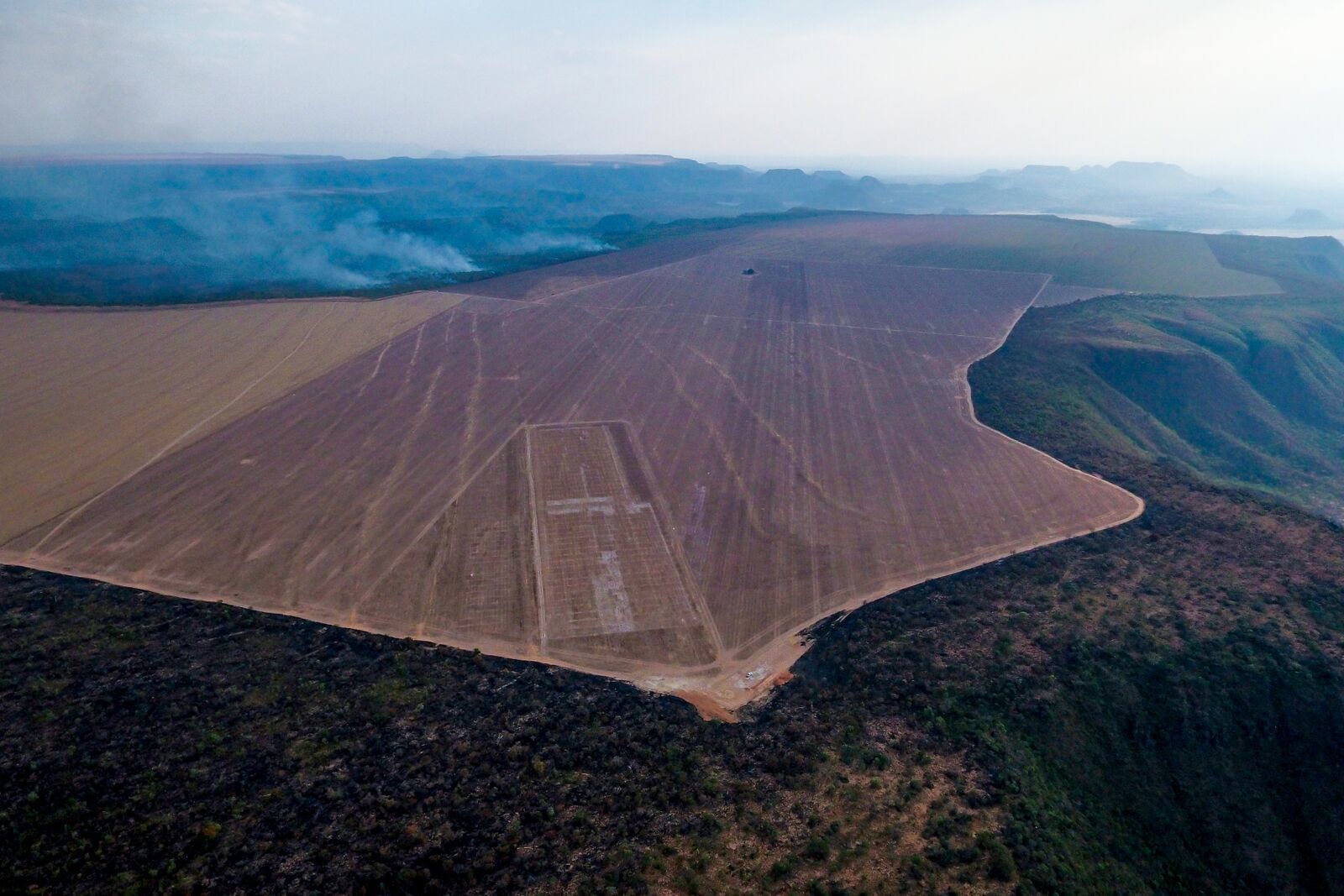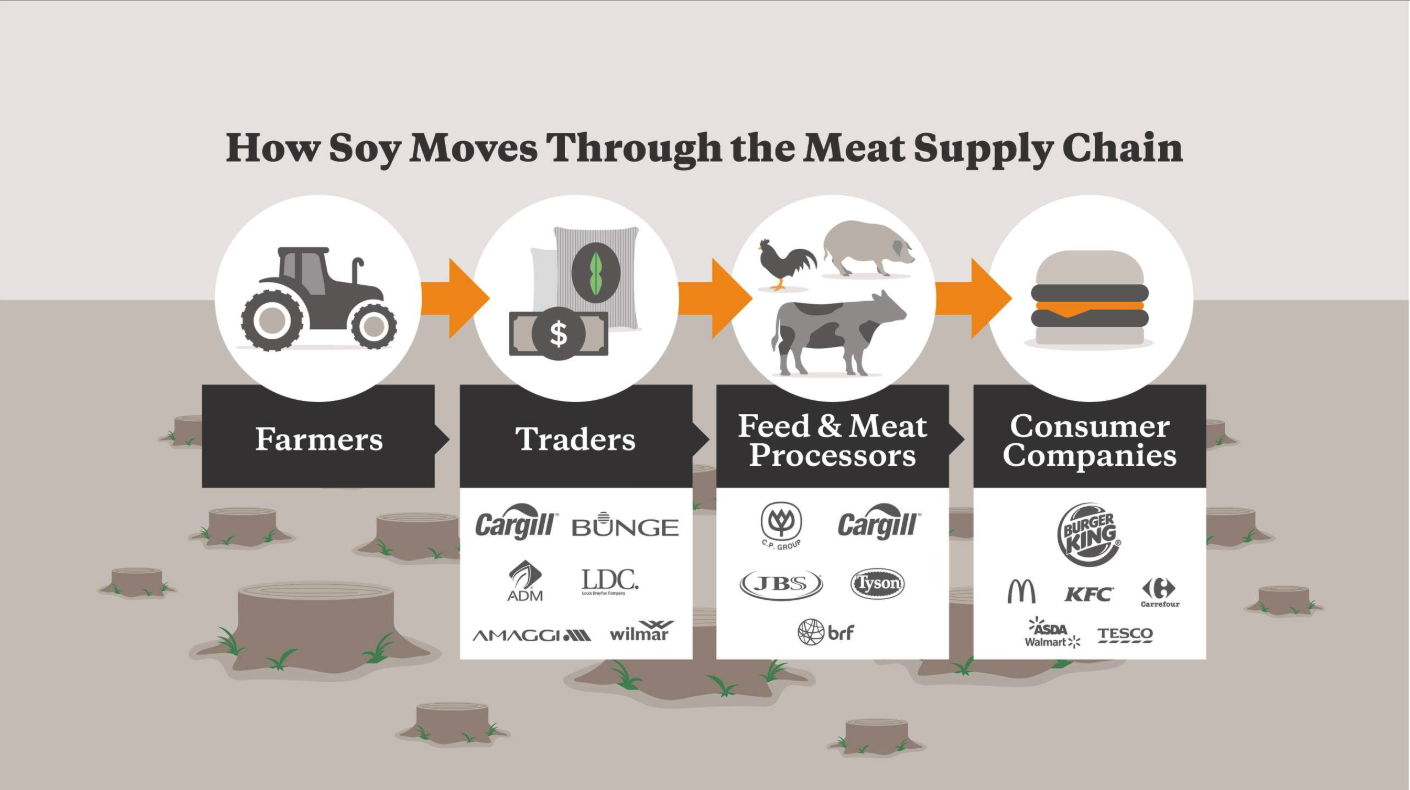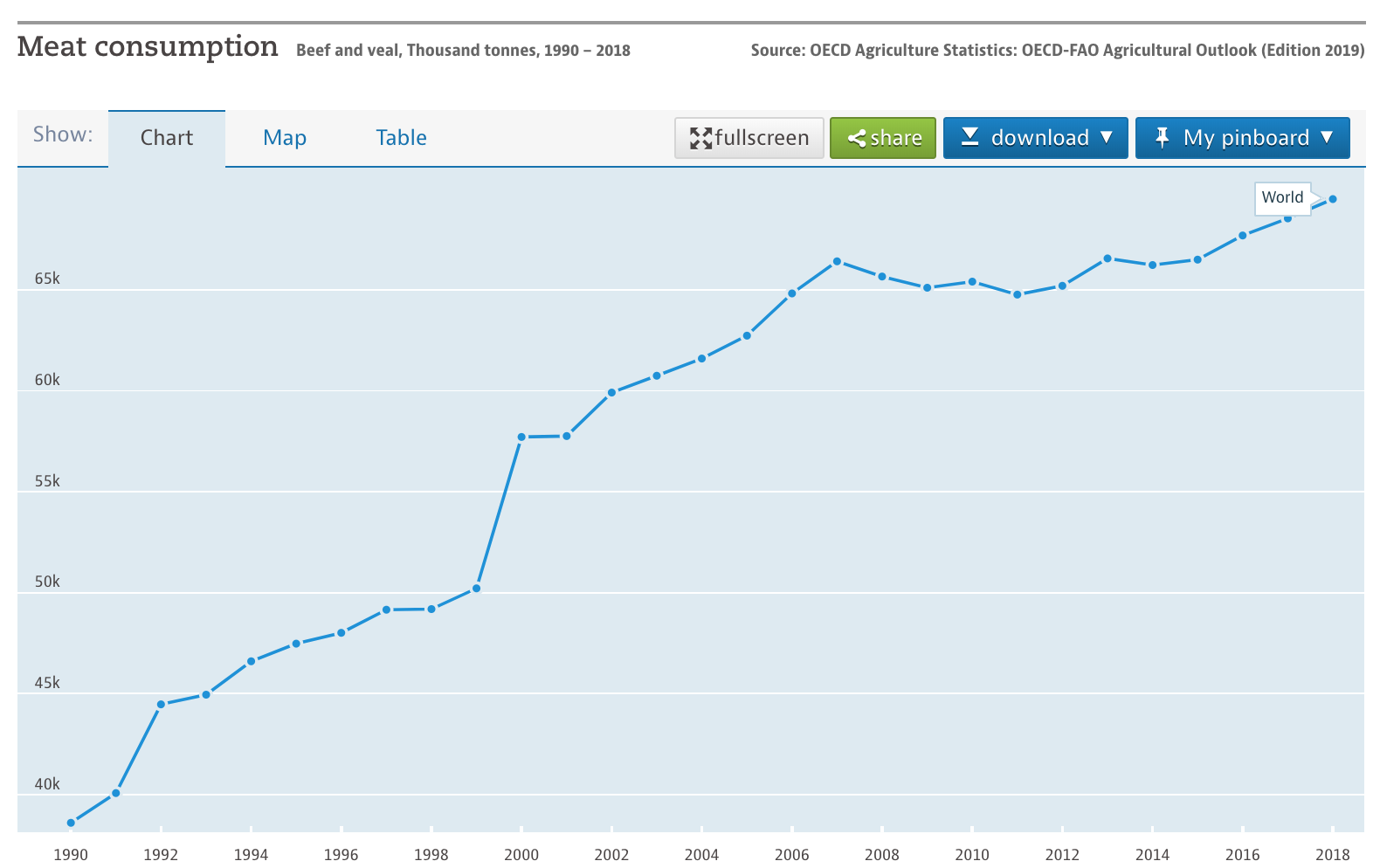As this very moment, people are intentionally lighting the Amazon rainforest on fire.
This ecological region of 2.12 million square miles — nicknamed the “lungs of our planet” — accounts for 25% of the carbon dioxide absorbed by the world’s forests and is one of our best defenses against runaway climate change. Yet we are burning it down with fires large enough to be seen from space at an ever-increasing rate:
According to data released by Brazil’s National Institute for Space Research (INPE), deforestation of the Brazilian Amazon in July 2019 increased 278 percent over the previous July.
Why is the Amazon rainforest — and countless other rainforests in South America — being purposely destroyed?
It’s just simple economics.
Farmers in South America are illegally setting fires in order to clear farmland on which to plant soy crops and raise cattle. The soy is fed to livestock; the cattle are slaughtered and sent to grocery stores and restaurants around the world.
 Photo credit: Jim Wickens/Ecostorm
Photo credit: Jim Wickens/Ecostorm
The rainforest is on fire because the world demands more beef and most of us ignore where our McDonald’s patties are coming from:
The incentive for the destruction comes from large-scale international meat and soy animal feed companies like JBS and Cargill, and the global brands like Stop & Shop, Costco, McDonald’s, Walmart/Asda, and Sysco that buy from them and sell to the public. It is these companies that are creating the international demand that finances the fires and deforestation.
 Photo credit: Mighty Earth
Photo credit: Mighty Earth

Every participant in this chain of events is complicit, from the firestarting farmers to the South American governments looking the other way to the distributors transporting beef across the globe to the consumer companies marketing demand for beef all the way down to all of us and our cravings for Big Macs.
Welcome to Game A, also known as “way the world works today”. Game A is our entire set of economic, political and social structures that allow us to cognitively disassociate from our negative externalities and to perpetuate systems of disproportionate power structures. It’s our capitalist markets, our culture, our laws, our democracies, our socialism.
Game A is built on a bedrock of competition, of win-lose games, of rivalry that values growth and wealth above all else. It’s a system that allows individuals, corporations, and governments to take actions without truly considering their future consequences, and then attempts to “patch” problems with after-the-fact regulations and philanthropy.
Game A invents creative new ways for people to connect online, then sees skyrocketing rates of psychiatric disorders in children and adolescents (17.1 million children in 2016, a 55.8% increase in just five years).
Game A allows a small pharmaceutical company to aggressively peddle a miracle pain drug to doctors, generate billions of dollars in sales, and make the owners the 16th wealthiest family in the U.S. in 2015 ($14 billion), yet results in a 491% increase in opioid drug overdose deaths, with over 200,000 reported American deaths from opioid drug overdoses in the last 20 years.
Game A and it’s narratives, laws, and compensation structures first began as humans transitioned from small nomadic hunter-gatherer tribes to initial agricultural civilizations and continues to our modern civilization today. And while Game A has taken us very far — helping humanity live longer and develop world-changing technology — many believe that we’re reaching our limits with the current ruleset.
As the world becomes more complex and interconnected and our problems become more wicked, the externalities that occur as a result of Game A thinking are increasing in magnitude. We are now a global, interconnected system with exponentially dangerous technology, and each major failure generates larger and larger ripple effects that can cause more dramatic and systemic crises.
And above all else, the cataclysmic threat of climate change is the ultimate example of the challenges of Game A, the tragedy of the commons playing out on a global scale.
The problems are mounting and many believe these existential crises are simply unsolvable with our current incentive structures today.
And if we don’t consider alternate forms and social structures, many worry these problems could accelerate into a civilization-collapsing event.
Enter Game B
Faced with the magnitude of our challenges today, a group of intellectuals, philosophers, technologists and biologists have begun to investigate alternatives to the current system. They’re asking questions such as:
- How might we proactively capture negative externalities and ensure individuals are fully responsible for the problems they generate?
- How might we ensure that all actions taken in the system benefit everyone else in the system?
- How can we incentivize individuals to move away from competition and rivalry towards cooperation and anti-rivalry?
- And how might we built resilient capabilities to tackle the complex, interconnected problems of climate change, income inequality, and loss of meaning?
Enter Game B.
Game B is described as “a collective space from which to consider potential future civilizational forms”.
It carries a specific mindset and mission: to develop an anti-fragile, scalable, and ever-increasingly omni-win-win civilization.
What does this mean?
Anti-fragile
The idea of anti-fragility comes from the book Antifragile by Professor Nassim Taleb. A system is anti-fragile if it gains an increased capability to thrive as a result of stressors, shocks, attacks, or failures on that system.
An example of a fragile system is a tea cup. When exposed to a stressor — such as falling out of your hand and crashing to the floor — it becomes worse under that pressure, shattering into tiny pieces.
But an anti-fragile system is the opposite. When exposed to a force or stress, it becomes STRONGER after rest and recovery. Your muscles are an anti-fragile system; after lifting weights, your muscles are pulled apart only to be built up with additional muscle growth during recovery.
An anti-fragile system is one that can absorb volatility, failures, or shocks and become BETTER from the experience. A future Game B system will need to incorporate elements of anti-fragility as exponential technological growth puts increasing pressure on our society.
Scalable
In order to make an impact on our major challenges, Game B will need the ability to scale, to eventually encapsulate all of the political, economic, and societal structures that are currently contained within Game A.
Before Game B scales, a proof of concept must first be established that demonstrates the advantages of a cooperative, non-rivalrous structure. And this prototype must be able to directly out-compete Game A on Game A’s terms.
A winning Game B prototype becomes an attractive alternative to Game A, generating a genuine and sustainable gravitational pull to a new way of thinking.
Only then will the Game B system prove itself as more valuable and viable than Game A and shift momentum towards a new collaborative society.
Omni-win-win
According to future thinker Daniel Schmachtenberger, an essential design constraint of Game B is that “the system must vector towards omni-win-win dynamics” and “at no point can it incent win-lose dynamics.”
In game theory, win-lose or zero-sum games contain both winners and losers. When I win, I benefit at the expense of others or the commons. I gain market share, you lose market share. I extract precious minerals from the ground, you get toxic runoff into your water supply.
But in an omni-win-win game, every participant — including the commons — attains value and benefit. To achieve this, all participants must collaborate together, using their individual needs as design constraints when defining a solution. Everyone must have an interconnected interest and care about one another and their outcomes.
–
So to recap: a Game B society gets stronger the more challenges you throw at it, directly outcompetes Game A, and creates benefit for all participants in the system.
I like to think of Game B as a realization of the “Star Trek future” we’ve all seen on TV: a post-scarcity society where everyone has their basic needs met, where individuals come together as a collective whole and can derive meaning, happiness, and fulfillment from their lives.

Sounds awesome right? And you might be thinking – especially with our current political and economic environment – how in the hell will we get to that future?
We’re going to have to start truly caring about each other’s best interests at both a local and global scale.
We’re going to need to listen and fully understand each other’s diverse perspectives.
And we’re going to have to dramatically re-structure our economic incentives to value collaboration over competition.
Each of these is a very tall order, but there is one human superpower we can draw upon to help us get there: sensemaking.
And by finding inspiration in our tribal roots, we can re-discover and amplify this capability to better make sense of the challenges of the future.
The importance of collective sensemaking
Collective sensemaking is our capability to comprehend our environment through the use of multiple senses. Our eyes see what happens and our ears pick up noises; we then process this information and create a mental model of what is happening around us. When senses are combined, a property called emergence occurs, where you gain a benefit that is greater than the sum of its parts.
A great example that demonstrates emergence is how our eyes work. Individually, an eye cannot perceive depth, but together, our eyes can use parallax to determine which objects are closer and which are further away.
Collective sensemaking is a superpower because it helps us develop situational awareness and understanding in environments of high complexity, ambiguity, or uncertainty. And when the perspectives of multiple individuals are combined, emergence as a group emerges.
This group emergence historically helped homo sapiens dominate our environment as hunter gatherer tribes of up to 150 people. However, our species does not have the ability to apply collective sensemaking past the Dunbar limit of 150 people, so we instead opted to scale civilization through weaker ties: through stories, laws, and hierarchical structures and systems.
But to truly become Game B players, we will need to figure out how to incorporate sensemaking beyond the 150 person limit, transforming into a culture where we care deeply about the needs of all of humanity, not just of our closest friends and families. We need to self-transcend and become the best possible version that we can be.
Becoming a Game B player
Join the conversation
The simplest way to get started on Game B is for an open-minded individual to simply join the conversation. The future of Game B is up to all of us, so developing capabilities to actively listen to one another through respectful, collaborative dialogue is essential.
Join the Game B Facebook group and participate in the nascent but very active community.
Or start a discussion with your friends, family, or colleagues about the ideas of Game B. See what they think and get ideas for how we might foster more collaboration or better align incentives in our communities, our workplaces, and our institutions.
Speak up against Game A decisions or incentives
Most companies and entities as we know them today are Game A, but they don’t necessarily need to be. We should all begin to challenge the status quo and push back against win-lose decision-making that doesn’t take into account the potential harm inflicted on third-parties.
The Business Roundtable recently made a splash declaring that the purpose of a corporation should transition from one that purely serves the interests of shareholders towards one that promotes the well-being of all stakeholders including customers, employees, and communities.
This is a great first step, but it’s up to us to hold these corporations accountable to this new standard.
Speak up. If you’re in a meeting at work and a win-lose decision is being discussed, make sure everyone thoughtfully considers how all parties will be affected, from customers to employees through to society as a whole. Push for omni-win-win solutions when possible and look to mitigate any second order negative effects that may occur.
Resources and Further Reading
On Game~B - This is the motherlode, a massive shared document on Game B maintained by James Allen. It includes more details on the origins and history of Game A from an evolutionary and game theoretic perspective. I’d recommend reading through this document after listening to a few podcasts.
Wait But Why: The Story of Us - A deep dive into the history of our society, starting with our evolution from single-cell organisms through to the emergence of human tribes to how we arrived at modern society today. This sweeping journey takes you through U.S. history, world history, evolutionary psychology, political theory, neuroscience, and more. With a ton of Game B undertones, this is a very captivating read!
Rebel Wisdom: Making sense of sensemaking - This extremely long podcast is a great place to start to get a comprehensive overview of Game B. “We’re probably not going to solve the complex, wicked, existential problems we face with individual horsepower playing rivalrous games. We need to get together and be able to create a higher form of collective intelligence and sense-making”
Zion 2.0: Distributed Intelligence w/ Jordan Hall - This podcast episode with complexity scientist and systems thinker Jordan Hall dives into the ideas of de-centralized or distributed collective intelligence and it’s ability to achieve vastly superior results by combining multiple distinct perspectives. A great example is your vision; your two eyes work together to develop a perspective that is more powerful than the sum of its parts. Humans used to be great at collective intelligence; Jordan dives into the history of human tribes and their sense-making abilities at the Dunbar size of ~150 people.
Future Fossils: Daniel Schmachtenberger (Designing A Win-Win World for Everyone) - Gold is scarce and monetarily valuable, but it has no true utility in our lives. Meanwhile, air is essential to our survival but is abundant and has no financial value. How might we change these dynamics? And what incentives can we change to build a totally redesigned global economy that benefits everyone?
Rebel Wisdom: Collective Intelligence Practice, Bonnitta Roy - Bonnitta speaks to our current levels of internalization of the current Game A system, including how even activist and protest groups interact in rivalrous ways. To succeed in the future, Bonnitta believes we have to reset and develop non-rivalrous practices.
Other Podcasts
- Joe Rogan: Bret Weinstein
- Future Thinkers: Jim Rutt – Game B: The Fifth Attractor, A New Social OS
- The Jim Rutt Show: Jordan “Greenhall” Hall and Game B
- Intellectual Explorers Club: Jordan Hall - The Philosopher Entrepreneur
